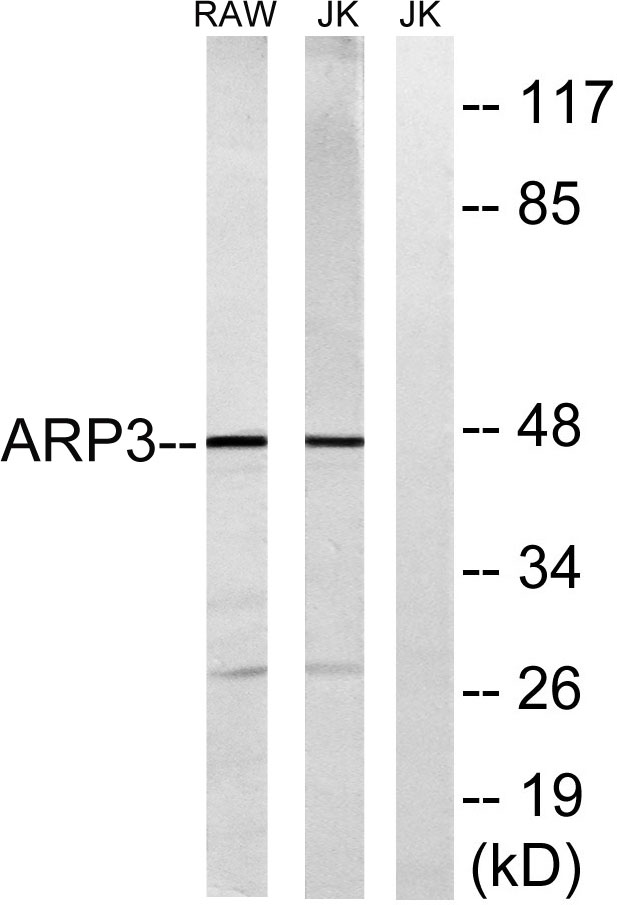Arp3 Polyclonal Antibody
- Catalog No.:YT0336
- Applications:WB;ELISA
- Reactivity:Human;Mouse;Rat
- Target:
- Arp3
- Fields:
- >>Endocytosis;>>Tight junction;>>Fc gamma R-mediated phagocytosis;>>Regulation of actin cytoskeleton;>>Bacterial invasion of epithelial cells;>>Pathogenic Escherichia coli infection;>>Shigellosis;>>Salmonella infection;>>Yersinia infection
- Gene Name:
- ACTR3
- Protein Name:
- Actin-related protein 3
- Human Gene Id:
- 10096
- Human Swiss Prot No:
- P61158
- Mouse Gene Id:
- 74117
- Mouse Swiss Prot No:
- Q99JY9
- Rat Gene Id:
- 81732
- Rat Swiss Prot No:
- Q4V7C7
- Immunogen:
- The antiserum was produced against synthesized peptide derived from human ACTR3. AA range:369-418
- Specificity:
- Arp3 Polyclonal Antibody detects endogenous levels of Arp3 protein.
- Formulation:
- Liquid in PBS containing 50% glycerol, 0.5% BSA and 0.02% sodium azide.
- Source:
- Polyclonal, Rabbit,IgG
- Dilution:
- WB 1:500 - 1:2000. ELISA: 1:40000. Not yet tested in other applications.
- Purification:
- The antibody was affinity-purified from rabbit antiserum by affinity-chromatography using epitope-specific immunogen.
- Concentration:
- 1 mg/ml
- Storage Stability:
- -15°C to -25°C/1 year(Do not lower than -25°C)
- Other Name:
- ACTR3;ARP3;Actin-related protein 3;Actin-like protein 3
- Observed Band(KD):
- 47kD
- Background:
- The specific function of this gene has not yet been determined; however, the protein it encodes is known to be a major constituent of the ARP2/3 complex. This complex is located at the cell surface and is essential to cell shape and motility through lamellipodial actin assembly and protrusion. Three transcript variants encoding two different isoforms have been found for this gene. [provided by RefSeq, Mar 2013],
- Function:
- function:Functions as ATP-binding component of the Arp2/3 complex which is involved in regulation of actin polymerization and together with an activating nucleation-promoting factor (NPF) mediates the formation of branched actin networks. Seems to contact the pointed end of the daughter actin filament.,similarity:Belongs to the actin family.,similarity:Belongs to the actin family. ARP3 subfamily.,subunit:Component of the Arp2/3 complex composed of ARP2, ARP3, ARPC1B/p41-ARC, ARPC2/p34-ARC, ARPC3/p21-ARC, ARPC4/p20-ARC and ARPC5/p16-ARC. Interacts with WHDC1.,
- Subcellular Location:
- Cytoplasm, cytoskeleton . Cell projection . Nucleus . In pre-apoptotic cells, colocalizes with MEFV in large specks (pyroptosomes) (PubMed:19109554).
- Expression:
- Brain,Cajal-Retzius cell,T-cell,
- June 19-2018
- WESTERN IMMUNOBLOTTING PROTOCOL
- June 19-2018
- IMMUNOHISTOCHEMISTRY-PARAFFIN PROTOCOL
- June 19-2018
- IMMUNOFLUORESCENCE PROTOCOL
- September 08-2020
- FLOW-CYTOMEYRT-PROTOCOL
- May 20-2022
- Cell-Based ELISA│解您多样本WB检测之困扰
- July 13-2018
- CELL-BASED-ELISA-PROTOCOL-FOR-ACETYL-PROTEIN
- July 13-2018
- CELL-BASED-ELISA-PROTOCOL-FOR-PHOSPHO-PROTEIN
- July 13-2018
- Antibody-FAQs
- Products Images
.jpg)
- Western Blot analysis of K562 cells using Arp3 Polyclonal Antibody

- Western blot analysis of lysates from Jurkat and RAW264.7 cells, using ACTR3 Antibody. The lane on the right is blocked with the synthesized peptide.



